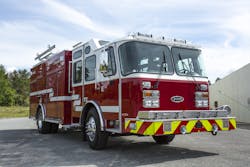E-ONE Introduces New Rear-Engine Pumpers
This week, E-ONE will be introducing a product at FDIC that is sure to be a “show-stopper” — a rear-engine pumper called the HS Series.
The completely new apparatus, designed from the ground-up, is not to be confused with the Hush, an apparatus that E-ONE had built 30 years ago. The new, sleek apparatus is based on the Cyclone design as well as E-ONE’s popular Quest cab and chassis.
Joe Hedges, aerial and chassis product manager for E-ONE, said the company began working on the project a year ago with no preconceived notions on what the product should end up being or how it would evolve.
Raff McDougall, manager of advanced product engineering at E-ONE, said his team looked at the former Hush product for inspiration.
“We took only the things that worked, improved upon them and designed everything from there,” McDougall said. The company stresses the new rear-engine pumpers are not a rehash of yesterday's design.
By moving the engine to the rear of the apparatus, E-ONE was able to achieve a surprisingly quiet cab and chassis with more room than one could imagine. Gone is the enormous “dog-house” that is typically found in custom cab apparatus. Virtually everything else about the apparatus looks normal, except the front and back of the HS Cyclone. The cooling vents are missing from the front and show up on the back instead.
In its place is a flat floor that gives more room for equipment and occupants. Below the floor, where the engine would normally be located, is a cavernous compartment that can be used for a variety of equipment and gear.
E-ONE engineers say it might be a place for the driver and officer to store their turnout gear. There's always more stuff in a cab than should be and the cabinet provides a place for it to travel safely and securely. They’re even thinking about installing a “carousel” kind of device that could be raised and lowered from the space to provide even more accessibility to equipment stored below the floor.
Visibility from the rear-seating area is also greatly improved. No longer do occupants feel as if they are seated in a cave peering over the dog house and through the narrow windshield.
Obviously, the engine needs to go somewhere and that is between the frame rails at the rear of the apparatus. The engine flywheel is facing toward the front of the apparatus with the cooling fan pointing toward the rear where all the engine cooling components are located. Integrated air dams on the sides of the apparatus, complete with filters, provide air intake louvers for engine and component cooling.
A transfer-like case, found on all-wheel drive vehicles, provides power to the rear wheels and, as an option, can easily provide power to the front wheels, McDougall said. Power for the fire pump is provided by means of conventional shafts, he added. The design also provides a very stable and balanced apparatus with a solid feeling ride.
To address accessibility to the engine and transmission, E-ONE developed an innovative system that moves portions of the rear body sides backward on mechanical slides that provides at least two feet of access to both sides of the engine. The moveable compartments, which extend and retract at flips of switches, can accommodate 500 pounds of equipment on each side and still move with ease well within its weight limits. For daily and routine maintenance, panels are provided for access to check oil and fluid levels.
The show apparatus is powered by a Cummins ISL 450 hp engine and an Allison 3000EVS transmission, which provides plenty of power and torque for the apparatus.
“It’s like a rocket ship,” said Hedges. And, he wasn’t joking. During a news media event, leading fire service publications were offered demonstrations and had the opportunity to drive the apparatus. The new pumper was surprisingly peppy with plenty of power.
Even more impressive was the 50-degree steering cramp angle which gave the apparatus a feel like a “zero-turn” lawn mowing machine. The wheel keeps turning and turning to the point where it feels like the apparatus is turning within its own wheel base.
Hedges said E-ONE balanced the hosebed height with the needed space for all the cooling equipment in the rear. He said they have come up with a good compromise, considering all the benefits firefighters get from having more room in the cab.
Lowering the noise level in the cab is a huge benefit of the HS Series. McDougall said less noise means less stress. And, moving the engine out of the cab also means its cooler as well, also taking away stress.
Heating and cooling in the cab is now done at three physical levels making for more even comfort, E-ONE engineers said.
Jay Johnson, the company’s vice president of sales and product management, said E-ONE did a lot of “voice of the customer” analysis to develop the new HS Series engine.
“We used three departments for our advisory panel,” Johnson said. “We wanted to make sure we had accountability to our customers on the design.” He added mechanics’ insight and comments were critically important when designing the new engine.
Both the Cyclone and Quest rear-engine pumpers were equipped with 750-gallon tanks and can have eMAX or conventional mid-ship pumps.
Price was also a consideration. Dan Peters, president of E-ONE said customers seeking the rear-engine design can expect to pay no more than 5 to 8 percent more for the option.
“These are for sale right now,” Peters quipped, motioning to the two gleaming show vehicles parked under a tent for the event.
Both rear-engine pumpers will be on the show floor at FDIC in Indianapolis later this week.
